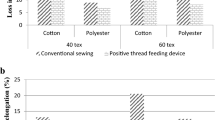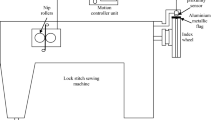Abstract
Due to their unique physicomechanical properties, polypropylene fibres can be used for twisted sewing thread of varying thickness. Regression equations which can be used to optimize production of PP thread are obtained. In processing of PP sewing thread with the structure 92.5 tex·1·3, the optimum values are 150 tw./m for the first twist and 70 tw./m for the second.
Similar content being viewed by others
REFERENCES
V. Bedenko and A. Polushkin, Tekhnich. Tekstil', No. 4, 34–37 (2002).
M. V. Sakhnik, in: Proceedings of the Interuniversity Scientific-Technical Conference “Current Problems in Textile and Light Industry” [in Russian], Part 1, RZITLP, Moscow (2002), p. 36.
A. G. Sevost'yanov, Methods and Agents for Investigating Mechanical Engineering Processes in the Textile Industry [in Russian], Legkaya Industriya, Moscow (1980).
A. B. Pakshver, Properties and Characteristics of Chemical Fibre Processing [in Russian], Legkaya Industriya, Moscow (1975).
Author information
Authors and Affiliations
Rights and permissions
About this article
Cite this article
Rodionov, V.A., Sakhnik, M.V. Optimization of Polypropylene Sewing Thread Production Technology. Fibre Chemistry 35, 208–211 (2003). https://doi.org/10.1023/A:1026161907354
Issue Date:
DOI: https://doi.org/10.1023/A:1026161907354




